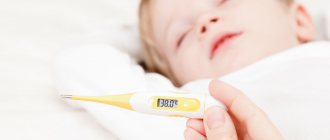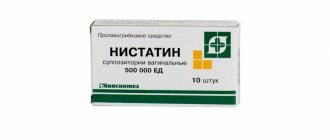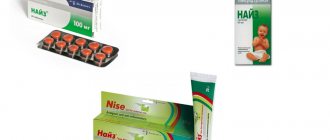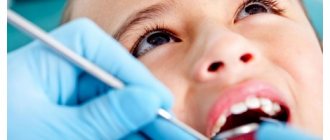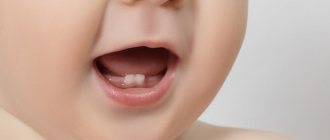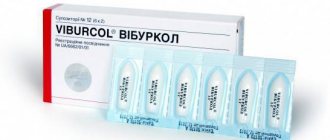Pharmacological properties of the drug Nurofen™ for children
The mechanism of action is due to inhibition of the synthesis of prostaglandins - mediators of pain, inflammation and temperature response. The drug has analgesic, antipyretic and anti-inflammatory effects, inhibits platelet aggregation. After oral administration, it is quickly and almost completely absorbed from the digestive tract. The maximum concentration of the active substance in the blood plasma is achieved 1–2 hours after administration. Ibuprofen is 90–99% bound to plasma proteins and penetrates into the synovial fluid. Metabolized in the liver to two inactive metabolites, which are quickly and almost completely excreted by the kidneys. A certain amount (10%) is excreted unchanged. The half-life is 2 hours.
What is Nurofen syrup and tablets for?
The action of Nerofen is explained by the presence of ibuprofen in the composition, which, by acting on the thermostat in the brain, relieves fever and returns the temperature to normal values.
In addition, ibuprofen inhibits the synthesis of prostaglandins, which are mediators of pain. Which explains its analgesic effect. This is why Nurofen is indicated for:
- high body temperature;
- toothache;
- headache;
- muscle pain;
- for adverse reactions after DTP.
Use of Nurofen™ for children
Oral only. The dose for children depends on the age and body weight of the child. Single dose - 5–10 mg/kg. The maximum daily dose should not exceed 30 mg/kg. Children aged 3 to 6 months - 2.5 ml of suspension (50 mg) every 8 hours, but not more than 7.5 ml (150 mg) per day. Children aged 6 to 12 months - 2.5 ml of suspension (50 mg) every 6 hours and no more than 10 ml (200 mg) per day. Children aged 1 to 3 years - 5 ml of suspension (100 mg) every 8 hours and no more than 15 ml (300 mg) per day. Children aged 4 to 6 years - 7.5 ml of suspension (150 mg) 3 times a day (450 mg). Children aged 7 to 9 years - 10 ml of suspension (200 mg) 3 times a day (600 mg). Children aged 10 to 12 years - 15 ml of suspension (300 mg) 3 times a day (900 mg). For fever after immunization (children aged 3–6 months) - 2.5 ml, if necessary - another 2.5 ml after 6 hours, but not more than 5 ml over 24 hours. The duration of use depends on the course of the disease and is usually 3 days
What temperature should be considered elevated?
Formally, this is considered a temperature above 37º. However, in healthy children of any age, after anxiety, physical activity, or simply after eating, the temperature can rise to 37.5 and even 38º. Healthy children in the first month of life also do not differ in accuracy in regulating their own temperature, and in premature infants and children with neurological problems, temperature instability can be observed at an older age. In these cases, the temperature measured after an hour is usually normal. Another condition that can lead to an increase in temperature in a healthy child is teething (or, in other words, dentition). In this condition, the temperature can rise to 38 degrees or more and last for more than a day. However, parents should not independently decide whether a prolonged increase in temperature is associated with teething. In this case, the child should be shown to a doctor - after all, the child’s teeth are cut almost continuously from 4 months to 2 years, and by regarding any increase in temperature as dentition, you may miss the onset of a serious disease, the only symptom visible to you (but not to the doctor) there was a fever. General overheating of the body can also lead to an increase in temperature, but after several hours of staying in comfortable conditions, the temperature becomes normal and no longer rises. Often the temperature rises after preventive vaccinations. Despite the fact that a moderate increase in temperature after some vaccinations is considered a normal vaccine reaction, in this case it is better to show the child to the doctor.
Side effects of Nurofen™ for children
Hypersensitivity may manifest itself as a nonspecific allergic reaction and anaphylaxis; exacerbation of asthma, bronchospasm; various skin rashes. From the gastrointestinal tract : nausea, vomiting, discomfort or pain in the epigastric region, laxative effect, possible exacerbation or development of gastric ulcer, bleeding. From the nervous system : headache, dizziness. From the hematopoietic organs : anemia, thrombocytopenia, agranulocytosis, leukopenia. From the urinary system : impaired renal function. If any side effect occurs, discontinue the drug immediately and provide proper care.
How many times can Nurofen be given to a baby?
The effect of the drug begins an hour after the first dose. The decrease in temperature can continue for up to half an hour until the values drop to normal levels. The antipyretic effect can last up to 8 hours. However, with severe inflammatory processes, the fever may return after 4-5 hours. An infant can be re-given a single dose of the drug both in the form of suppositories and in the form of syrup after 4 hours if the temperature begins to rise again. A baby can receive up to 5 permissible single doses per day.
Special instructions for the use of Nurofen™ for children
The drug should be used with caution when:
- systemic connective tissue diseases;
- hypertension (arterial hypertension) and/or heart disease;
- liver and/or kidney failure.
If gastrointestinal bleeding or ulcers develop, the drug should be discontinued immediately. In patients with severe dehydration, ensure sufficient fluid intake. Particular caution must be exercised when used in children with severe dehydration due to diarrhea, after major surgical interventions, with cardiac, hepatic and renal failure, when using diuretics. In these cases, careful monitoring of diuresis and renal function is necessary.
How to reduce a child's fever
Do you need to deal with high fever? If yes, how should this be done? The answer to these questions depends not only on the specific temperature numbers, but also on the characteristics of your child, on the nature of the disease that caused the increase in temperature and many other factors known only to you and your pediatrician (the author of this article does not know your child). In any case, the prescriptions of a doctor who examined the child will be much more valuable than any correspondence recommendations. However, you may find yourself in a situation where emergency medical consultation is not possible. To do this, you don’t have to go to a desert island - it’s enough to be in the compartment of a long-distance train or in a garden plot with your mobile phone turned off. In addition, knowledge of the rational principles of reducing temperature will help you correctly assemble a home first aid kit: medical recommendations, expressed orally or written down on paper, do not have an independent antipyretic effect, and you still need to get to the nearest pharmacy on duty. In most cases, a temperature below 38º is not dangerous, does not affect the child’s well-being and does not need to be reduced. The desire of parents to achieve a normal temperature in a sick child is completely unjustified - it’s not even that this turns off one of the natural factors of the body’s resistance, it’s just that the unnecessary use of antipyretic drugs is undesirable, because There are no absolutely safe and harmless medications. Temperatures above 38º should be reduced if the child does not tolerate it well (he often does so). Temperatures above 39º certainly need to be lowered, but you will still have to use antipyretic drugs, so I will have to tell you more about them.
When you look at a pharmacy shelf labeled “antipyretics,” you will be surprised by the number of bottles and boxes with different names. In fact, this variety is apparent - the fact is that the name on the package is a trade name and does not reflect the composition of the drug. So, for example, PANADOL, EFFERALGAN, TYLENOL, CALPOL, DALERON, PARAMOSHA, CEFEKON D (all these drugs are found in our pharmacies) are ordinary paracetamol. While abroad, you can find the same paracetamol under the names DOLIPRAN, ALVEDON, PARAMOL and others (by the way, you should not expect that the local doctor will explain everything in detail - in many countries this is simply not accepted). Only good eyesight will help you understand this confusion - the fact is that each package must have the international name of the drug written in small letters: for paracetamol it will be “paracetamol”, “acetomiphen” or “acetominophen”. Today, paracetamol is the most common antipyretic drug for children. The use of paracetamol in normal doses is harmless for most children, however, if your child suffers from chronic liver disease, has suffered hepatitis or prolonged jaundice of newborns, this drug should not be used without consulting a doctor. Allergic reactions to paracetamol are rare; much more often the child reacts to dyes and taste-improving substances included in paracetamol preparations for children. Therefore, if a child develops a rash after taking Panadol, it makes sense to try Efferalgan or Tylenol - perhaps everything will be fine. NUROFEN FOR CHILDREN is an antipyretic drug based on ibuprofen (abroad, look for the word “ibuprofen” on the packaging). In terms of its antipyretic effect, ibuprofen differs little from paracetamol, but it lasts slightly longer. This drug in normal doses is slightly toxic and is widely used in modern pediatrics. Unfortunately, ibuprofen preparations are only available for oral administration; rectal suppositories based on it are not produced. Just remember that ibuprofen is not approved for children weighing less than 5 kg. In addition, ibuprofen should not be used if the child has ever had a decrease in the number of white blood cells in the peripheral blood. Acetylsalicylic acid (ASPIRIN) is one of the oldest antipyretic drugs. However, today this drug is prohibited for use under 15 years of age - age-related metabolic characteristics cause a higher toxicity of this drug specifically for children. The use of aspirin is especially dangerous in children of the first two years of life, as well as those suffering from bronchial asthma or prone to nosebleeds. ANALGIN (international name - metamizole) is a very effective antipyretic drug. A feature of this drug is the rapid onset of the antipyretic effect (especially when administered intramuscularly), but the duration of this effect is short. In many countries, this drug is not approved for use - with long-term and frequent use, analgin can disrupt hematopoiesis, leading to a decrease in the number of leukocytes. In Russia, this drug is used mainly as an emergency treatment - leukopenia (decrease in the number of white blood cells) - a very rare complication and practically does not occur with occasional use of analgin. Conclusions: firstly, analgin can be used in children, but only as an additional antipyretic drug; secondly, if you plan to use analgin when traveling abroad, you will have to take it with you. An additional argument in favor of using analgin is the following consideration: if you fail to reduce the temperature to acceptable levels using paracetamol, you will have to call emergency help, whose doctor will certainly help your child by injecting the same analgin intramuscularly. Of course, analgin should not be used in children with leukopenia of any origin.
How to use antipyretic drugs?
Most of them are available in child-friendly forms - fruit-flavored syrups. However, if your child suffers from food allergies, it may be better to separate, crush into powder and give the child part of the tablet with a little water - this way you will avoid the risk of allergic reactions to dyes and flavorings. We should not forget that in addition to the mouth, the child also has other physiological openings suitable for administering medications - this means the use of rectal suppositories. Most antipyretic drugs are available in suppositories of various dosages. If only suppositories with too large a dose of the drug are available, they are treated in the same way as with tablets - the required part of the suppository (naturally, the front, pointed one) is separated with a knife and inserted into the anus, not forgetting to first lubricate the anus with baby cream , or the candle itself. What is preferable, mouth or butt? There are no fundamental differences in the action of the drug or the rate of absorption, choose what is more convenient for you.
How often can antipyretic drugs be used?
It is recommended to take paracetamol no more than four times a day, however, if necessary, the interval between doses can be reduced to four hours. Analgin and ibuprofen (Nurofen) should not be taken more than three times a day. How to calculate the dose of an antipyretic drug? You shouldn’t do this yourself; a child’s illness is not the best time for mathematical exercises; you should consult your doctor in advance. Of course, each package of antipyretic medication contains a leaflet with dosage instructions, but these instructions do not take into account the characteristics of your child. By the way, in these leaflets there is often an instruction that completely disorients parents: “It is not recommended to take the drug for more than three days” - you can safely ignore this instruction. It is intended for countries where it is not customary to show the child to the doctor in the first days of the disease, and has the following meaning - if after three days of self-treatment the temperature has not become normal, you should stop doing it yourself and show the baby to the pediatrician.
What to do if four hours have not yet passed, and the temperature begins to rise again and exceeds 38º?
In this case, your child will benefit from wiping with water at room temperature. With a large piece of cotton wool soaked in the mixture, you should (like a brush) moisten the entire skin of the child from neck to heels, while it is advisable to cover the perineum, and the axillary and groin areas (locations of large vessels) should be treated several times. After wiping the child, you must leave it open for 1-2 minutes, after which you can gently blot it. Properly performed wiping acts quickly and effectively, but this effect is quite short-lived. It's not scary, because... Rubbing can be done as often as you like. But against the background of severe chills, pallor, cold feet (signs of a pale fever), you should not wipe yourself off; first you need to turn the pale fever into pink, about which a little later.
What to do if antipyretic drugs do not help?
The fact is that elevated temperature (fever) in children can occur in two variants: pink fever and pale fever. When a child has pink fever, the skin looks brighter than a healthy person, it feels hot to the touch, including on the hands and feet; in children older than one year, pink fever is usually accompanied by increased sweating. With pink fever there is no disturbance in heat transfer, so taking antipyretics is usually effective. With pale fever, usually only the head and natural folds remain hot; the feet or hands may be especially cold. The skin is pale or marbled (i.e., with uneven coloring). Chills and goose bumps are also signs of pale fever. The causes of this condition are spasm of the skin blood vessels, the consequences are impaired heat transfer, the inability to determine the temperature “by touch”, lack of response to conventional antipyretic drugs and rubbing. Pale fever is a very unpleasant condition: vascular spasm is not limited to the skin, but blood circulation in the tissues is disrupted, pathological changes in metabolism increase, and the acid-base balance is disturbed. Therefore, the first priority for pale fever is the elimination of vascular spasm, i.e. conversion of pale fever to pink. This can be achieved by using vasodilating drugs - NO-SHPA tablets or PAPAVERINA suppositories (by the way, you won’t find NO-SHPU abroad either, take it with you). You can mask the disgustingly bitter taste of NO-SHPA by giving it in one spoon with antipyretic syrup. An additional measure to eliminate vascular spasm is warming the feet. There is no need to be afraid of this procedure - a heating pad applied to the feet will not lead to an additional increase in temperature; by relieving vascular spasm and improving heat transfer, the temperature can only decrease. Under no circumstances (despite the chill) should you wrap your child warmly - this will further worsen heat transfer. In general, the ideal clothing for a feverish child is his own skin plus woolen socks.
What should you do if you are not sure whether your child has signs of fever?
In this case, follow a very simple rule - it is better to give vasodilators when they are not needed (these drugs are practically harmless in age-related doses) than to skip them when they are needed. By the way, a fever above 39º should always be considered pale (without disturbances in heat transfer, the temperature simply will not rise to such figures). All of the above recommendations can be presented in the form of a short diagram, which can be conveniently rewritten and placed in a children's first aid kit.
SCHEME OF APPLICATION OF ANTIBREAKER AND VASUDODILATORS DRUGS AT HIGH TEMPERATURE IN CHILDREN.
1. Temperature below 38º - does not need to be reduced.
2. Temperature 38 - 39º
2.1 PINK FEVER Signs: pink skin, warm feet, no chills. Medicines: PARACETAMOL or NUROFEN
2.2 PALE FEVER Signs: pale or marbled skin, cold feet, chills or goose bumps. Medicines: PARACETAMOL or NUROFEN + NO-SPA or PAPAVERINE
3. Temperature above 39º Medicines: PARACETAMOL or NUROFEN + NO-SPA or PAPAVERINE + ANALGIN
Note: this scheme cannot be used if: 1. The child is under three months old. 2. The child suffers from a serious chronic illness. 3. The child has a history of unusual reactions to one of the recommended medications. 4. There are contraindications to the use of one of the recommended drugs. 5. The attending physician has prescribed a different procedure for using medications.
What to do if, despite following all the recommendations, the thermometer does not fall below 39º or signs of vascular spasm (pale fever) persist?
In this case, you will still have to call emergency help . An emergency examination by a doctor in this situation is absolutely necessary - perhaps it’s time to change something in the treatment regimen.
In conclusion, I would like to provide an approximate list of antipyretic drugs for your home medicine cabinet. You should complete your first aid kit in advance - children often get sick at the most inopportune moment, when there is no time and no one to run to the pharmacy.
1. Any syrup with PARACETAMOL or NUROFEN FOR CHILDREN. 2. Suppositories with PARACETAMOL or IBUPROFEN in the dose recommended by the attending physician. 3. NO-SPA tablets 40 mg. 4. Suppositories PAPAVERINE 20 mg. 5. Tablets ANALGIN 500 mg. 6. Emergency phone number.
Kanter M.I. Pediatrician of the highest category
Interactions of Nurofen™ for children
Concomitant use with:
- acetylsalicylic acid or with other NSAIDs and GCS drugs (the risk of side effects from the gastrointestinal tract increases);
- anticoagulants (increasing the effect of oral anticoagulants and increasing the risk of bleeding).
Use cautiously simultaneously with:
- antihypertensive drugs and diuretics (increased risk of developing a reaction from the kidneys);
- methotrexate and lithium drugs (increased levels of these drugs in the blood plasma);
- cyclosporines (drug interactions are possible, which can lead to an increased risk of nephrotoxicity).
If Nurofen does not bring down the temperature: what to do
When the thermometer rises above 39˚C, absorption of substances from the stomach may stop. This means that taking medications orally may not have an effect. This happens especially often when the patient washes down the tablet or syrup with cold water. Once in the stomach, cold liquid forces the vessels of the gastric walls to contract, as a result of which they cannot fully pass substances through their walls.
In this case, doctors recommend giving preference to rectal suppositories at high temperatures exceeding 39˚C. The suppository, once in the rectum, quickly dissolves, and ibuprofen immediately enters the bloodstream through the intestinal walls. After 30-40 minutes, the patient’s temperature begins to decrease.
Overdose of Nurofen™ for children, symptoms and treatment
Increasing the dose to 400 mg/kg may cause acute intoxication, which may be accompanied by nausea, vomiting, abdominal pain, dizziness, headache, drowsiness, nystagmus, blurred vision, tinnitus and, rarely, decreased blood pressure, metabolic acidosis, and renal failure. and loss of consciousness. When the first signs of overdose appear, you should immediately stop using the drug and carry out symptomatic therapy. There is no specific antidote.
Which is safer Nurofen or paracetamol
Ibuprofen, which is part of the drug, is contraindicated for people with chronic bronchial diseases, in particular asthma. In addition, Nurofen should not be taken by patients with intolerance to the active substance, pregnant women, patients with heart failure, diagnosed liver failure and gastrointestinal bleeding.
Contraindications to taking paracetamol are the neonatal period, individual intolerance to the drug, and gastric ulcers, including erosion and inflammation of the gastrointestinal mucosa.
